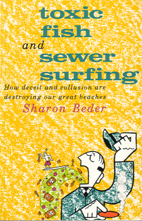
by Sharon Beder
first published by Allen & Unwin, Sydney, 1989
Introduction
Sewers seaward
Toothless watchdog
Toxic fish
Sewer-side surfing
Public relations battle
Events of 1989
Beyond Sydney
Conclusion
Bibliography
Very few surveys of the effect of industrial waste discharge on marine life have been carried out in Sydney and those that have have tended to concentrate on the existence and numbers of species. Recently an ex-Water Board employee, Ron Snape, a marine biologist, told the press that while he was conducting a survey of marine life of Sydney’s outfalls for the Board in 1973, he carried out tests for concentrations of heavy metals and organochlorines although this as not part of his brief. He claims that be found concentrations of mercury, zinc, cadmium and dieldrin in the samples caught near the Malabar outfall and the blackfish had six times the concentrations of mercury almost maximum safety levels for seafood. He says the Water Board did not want to know and he was forced to resign over it. He was coaxed back into their employment and completed the report of his 1973 survey in 1975 but claims that the report was heavily rewritten and distorted.
The results of this study (shown in Figure 3.1), which was carried out in 1973, were not published until the end of 1979. Heavy metals and/or pesticides were accumulating in nearly every species sampled and out of 18 organisms (including fish and mussels) taken near the outfalls, more than half ( 10) were so contaminated that they were above health limits set by the National Health and Medical Research Council.
Figure 3.1 Concentrations of heavy metals in marine life
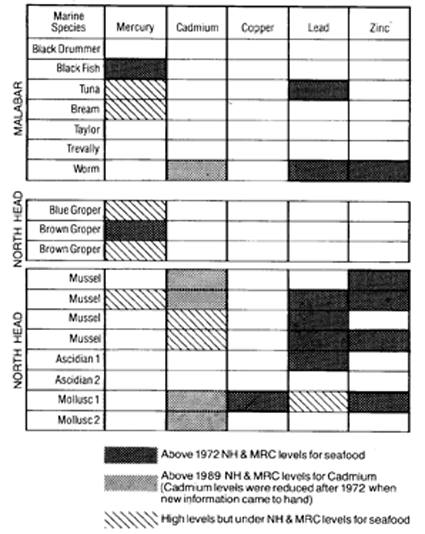
These are the results of Ron Snape’s survey. They show that most of the marine life caught near the outfalls and tested for heavy metals were contaminated.
Information from: Caldwell Connell, 1973.
In October 1973 a confidential report by the Board’s consultants, Caldwell Connell Engineers, had included this statement:
A meeting of personnel involved in various aspects of the study was held at the Australian Museum on the morning of October 18, 1973 to discuss the findings and develop recommendations . . . It was agreed that, while the data only represented analyses of individual specimens, levels of heavy metals and pesticides detected in this small number of samples were such as to suggest that a potential public health threat or environmental hazard might exist within the study area . . . Examination of the gut contents of a number of species of fish in the outfall areas shows that they derive a large percentage of their diet from food particles in the sewage. These fish, in turn, may constitute a significant proportion of the diet of persons who regularly fish in these areas.
It was concluded that more intensive studies of heavy metal and pesticide levels in the marine environment off Sydney should be undertaken as a matter of some urgency and that the studies should deal initially with the flesh of edible fish (Caldwell Connell, 1973).
NH & MRC MAXIMUM RESIDUE LIMITS In Australia the National Health and Medical Research Council (NH & MRC) recommends maximum levels of various toxic substances for food stuffs, including seafood. These figures are based on average Australian dietary habits and what little is known about the toxicology of the substances in question. The levels are set for individual toxic substances and do not seem to take account of the possible synergistic (multiplying) effects of more than one heavy metal or organochlorine being present in one fish. |
|---|
The intensive studies recommended were to include further and more comprehensive surveys of fish, surveys of consumption of fish by people who might be at risk, finding whether sewage or industrial wastes in stormwater were the source of heavy metals and pesticides in the ocean, and the evaluation of ways of reducing the levels of those substances. These studies were never carried out. Caldwell Connell went on to complete and publish their million-dollar feasibility study into the extended ocean outfalls, which did not mention the 1973 study. They stated in that study that a detailed investigation of levels of pesticides and heavy metals in the marine environment was beyond their scope (Caldwell Connell, 1976). They designed the outfalls to meet SPCC standards for concentrations of heavy metals and pesticides allowed through the outfalls. (These are discussed in chapter 2 pp. 39-41.) These standards were set in 1974 upon request from the Board and its consultants-dearly an attempt to avoid investigations that could have had embarrassing results.
It is not known whether the results of the 1973 study were given to the SPCC at the time, but the standards they set did not incorporate any further fish studies. The Board did not begin monitoring its discharge, nor did it change its trade waste policy. In fact, when part of the study was published in the Environmental Impact Statements in 1979, the Board actually stated that: ‘Whilst the statistical significance of the 1973 survey is not able to be clearly established the results are encouraging in that they indicate that no serious environmental problem existed even prior to the full implementation of source control of restricted substances . . .’ (MWS&DB, Bondi EIS, 1979). This sort of statement in an Environmental Impact Statement is misleading at the very least, given the concern of those involved with the survey. At least two other studies of contamination of fish near the outfalls, undertaken by the Fisheries Research Institute, were not mentioned in the Environmental Impact Statements nor were they published elsewhere. In one study (shown in Figures 3.2 and 3.3) seven out of eight blue groper and one red morwong out of eight sampled from Manly waters were above the NH&MRC maximum allowable levels for mercury. Yet the Fisheries Research lnstitute made no mention of these results in their submission approving the Water Board extended outfalls in 1980.
Figure 3.2 Mercury in North Head fish, 1973–89
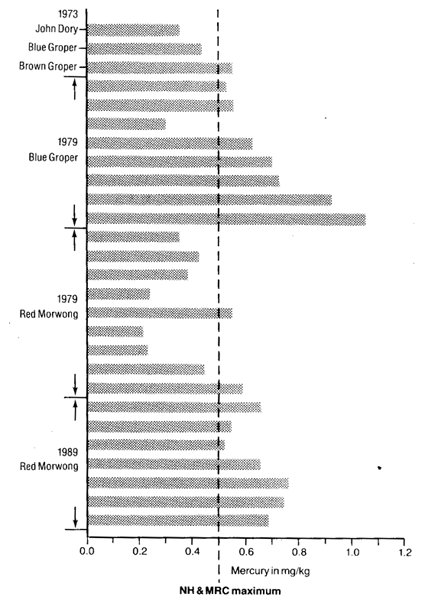
The levels of mercury in fish caught near the North Head outfall are getting progressively worse. The blue groper taken in 1973 was below NH & MRC maximum recommended levels but by 1979, 7 out of 8 were above those levels. The red morwong were nearly all below the NH&MRC maximum in 1979 but were all over that maximum in 1989, ten years later.
Information from: Caldwell Connell, 1973; FRI correspondence to SPCC, December 1985; SPCC, Vol I, 1989; Water Board Scientific Services, Report on Heavy Metals in Red Morwong, February 27, 1989.)
Figure 3.3 Mercury in Malabar fish, 1973–89
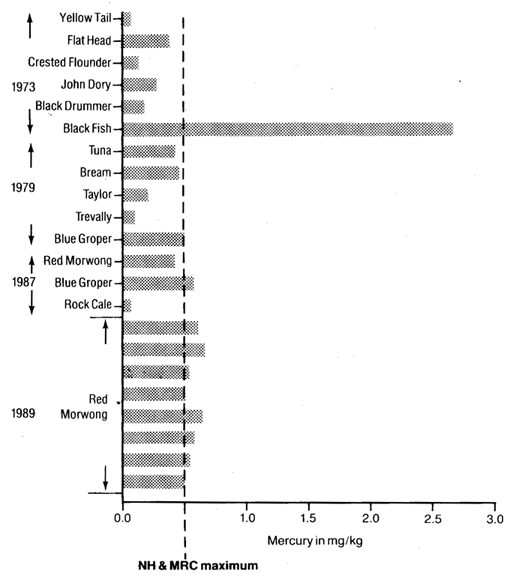
The blackfish accumulates mercury very easily. The blackfish caught in the 1973 study had more than five times the maximum level recommended by the NH & MRC. A blackfish caught in 1989 by the ‘Midday Show’, Channel 9 study had more than twelve times the maximum recommended level. The red morwong were consistently over the limit in the 1989 survey.
Information from: Caldwell Connell, 1973; FRI correspondence to SPCC, December 1985; Water Board Scientific Services, Report on Heavy Metals in Red Morwong, February 27, 1989.)
The second study by the Fisheries Research Institute was kept secret for years. Attempts by STOP, the Australian Conservation Foundation and by the then shadow minister or the environment, Tim Moore, to find out the results of the study were unsuccessful. In the study (shown in figures 3.4 and 3.5), which was finally published in an obscure Department of Agriculture report in 1987, (FRI, Part II, undated), blue groper and red morwong were collected between 1977 and 1979 near the ocean outfalls and tested for pesticides. Three of 40 blue groper specimens exceeded NH&MRC maximum levels for dieldrin. Ten of 58 red morwong exceeded the same levels for dieldrin and five had DDT body burdens in excess of NH&MRC maximum levels for total DDT. At least one red morwong had DDT levels that were 64 times the NH&MRC maximum levels and one had levels of dieldrin at 13 times the maximum levels. PCBS (polychlorinated biphenyls) were also detected in high levels and Although the Fisheries Research Institute claimed that these were safe levels (the NH&MRC have not set limits for PCBs in food), the levels exceeded overseas standards.
Figure 3.4 DDT in red morwong, 1979
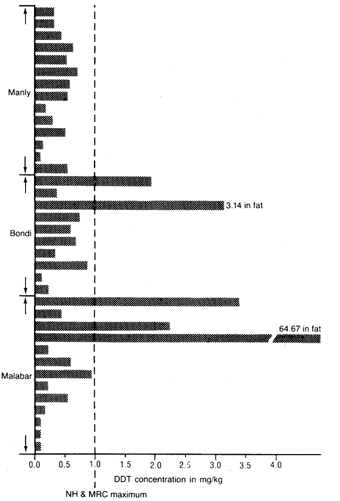
DDT does not occur naturally yet it was detected in all fish caught near the outfalls in the 1979 survey. Higher levels were recorded near the Bondi and Malabar outfalls, in some cases two or three times the NH & MRC maximum recommended levels for seafood. The fat tissue was only sampled in two of the fish but in those DDT levels were very high, more than 60 times the maximum recommended level in one fish.
Information from: FRI, undated
Figure 3.5 Dieldrin in red morwong, 1979
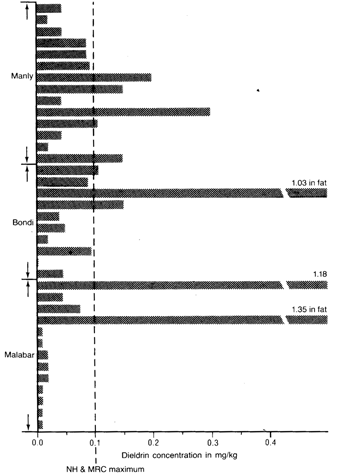
Dieldrin does not occur naturally, yet it was detected in almost all fish caught near the outfalls in the 1979 survey. Higher average levels were recorded near the Manly and Bondi outfalls, but the highest level was recorded at Malabar, over ten times the NH & MRC maximum recommended levels for seafood. The fat tissue was only sampled in two of the fish but in those Dieldrin levels were very high, more than 13 times the maximum recommended level in one fish, the same fish that had DDT levels of 60 times maximum recommended levels in its fat.
Information from: FRI, undated
A study by the New South Wales Hea1th Commission of PCBS in fish in Sydney waters, including Malabar sewage outfall waters, was done for the Australian Environment Council in the early 1970s but even experts in the field found interpretation of the results difficult because of the way they were presented. It was possible to say, however, that large quantities of PCBS had been detected in bream and mullet and smaller amounts in blackfish and oysters.
By the end of the 1970s, at least Eve government bodies knew that toxic industrial waste was accumulating in marine life near Sydney's outfalls; the Water Board, the Fisheries Research Institute, the Hea1th Commission (which had carried out the analysis of Fisheries Research Institute fish), the Australian Museum and the SPCC. Yet none of these bodies and none of their employees chose to make public that knowledge and only the Australian Museum expressed any concern about this problem when the Environmental Impact Statements were published.
Most astounding have been the very recent bioaccumulation studies undertaken by the SPCC on behalf of the Board. The first study (shown in Figures 3.6 and 3.7) undertaken during 1987 was not published until after results were leaked to the newspapers in 1989. In that study all three fish species sampled (red morwong, blue groper and rock cale) showed average levels above the NH&MRC guidelines for several heavy metals (including lead, cadmium and mercury) in their livers. The red morwong and the blue groper also had average levels of organochlorines in their muscle tissue well above NH&MRC guidelines. The eight red morwong taken at Malabar, in fact, had average levels of benzene hexachloride (BHC) over 120 times the NH&MRC maximum levels and heptachlor epoxide over 50 times. They also had dieldrin and arsenic in the muscle tissue above NH&MRC levels. (SPCC, 1989)
Figure 3.6 Organochlorine contamination of fish, 1987
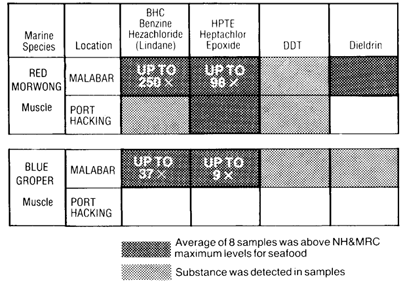
Three fish and three invertebrates were tested in the 1987 Malabar Bioaccumulation Study. Two of the three fish species had huge amounts of organochlorines in their muscle tissue. The red morwong and the blue groper had BHC, HPTE, DDT and dieldrin in them, although these substances do not occur naturally. The levels of BHC were astounding; the eight red morwong caught at Malabar had an average of 122 times the NH&MRC maximum recommended level for seafood, with the worst of the eight having 250 times that level.
Information from: SPCC, vol 1, 1989
Figure 3.7 Heavy metals contamination of marine life, 1987
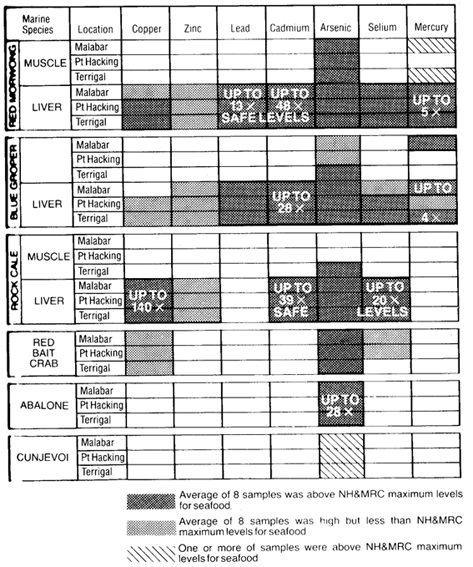
Three fish and three invertebrates were tested in the 1987 Malabar Bioaccumulation Study. All three fish species had very high levels of a range of heavy metals in their livers. Mercury and arsenic were found to have accumulated badly in the muscle tissues of the red morwong and the blue groper caught at Malabar. The livers were not tested in the subsequent 1989 study of heavy metals in red morwong.
Information from: SPCC, Vol 1, 1989
The second study (shown in Figure 3.8) tested red morwong at a variety of sites along the Sydney coastline. It again found high levels of organochlorines, including chlordane 12 times the NH&MRC limits and hexachlorobenzene (HCB) at 3 times the limits, along with excessive levels of PCBS. Some fish, particularly near the Malabar outfall, also had levels of DDT and dieldrin above NH&MRC limits. In an accompanying study, fish all along the coast from North Head to Malabar were found with above NH&MRC levels of mercury. Strangely, the livers of the fish were not tested, although this is the prime site of accumulation of heavy metals (SPCC, 1989).
Figure 3.8 Organochlorine contamination of fish, 1988
The 1988 Bioaccumulation Study only surveyed one fish species, red morwong. This time a different set of organochlorines was found, including the pesticides chlordane, DDT and dieldrin and the intractable wastes HCB and PCBs. None of these substances occur naturally. The fish caught near the North Head outfall had levels of chlordane that were up to 26 times the NH&MRC maximum recommended level for seafood and those caught near Malabar had up to 34 times those maximums. The discharges from the sewerage outfalls were particularly implicated by this study. Very few fish caught were not contaminated to some degree.
Information from: SPCC, Vol 1, 1989
Fish accumulate toxic materials at various levels, depending on species, age, season, feeding habits, and so on. The 1987 Malabar study and others made it clear that blackfish, red morwong, blue groper and the wobbegong shark tend to accumulate toxins more readily than other species. So the Water Board decided not to monitor any of those. Instead they chose the snapper, with some monitoring of the stingray, the nannygai, the tarwhine and the leatherjacket for their ocean outfalls monitoring programme. The invertebrates that they chose to monitor were not the mussel or the ascidian or the mollusc, which went over NH&MRC levels in 1973, or the red bait crab or abalone, which had elevated levels of copper and arsenic in the 1987 SPCC study, but the Balmain bug, the prawn and the squid. More recently, since the media blitz of early 1989, the SPCC has insisted that the Board do another survey of fish from which they should choose appropriate species to monitor. The number of fish to be surveyed and the species chosen by the Board will depend on what is caught by a trawler over two days and may or may not give a true indication of the accumulation that occurs.